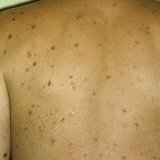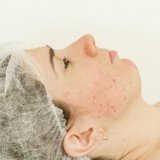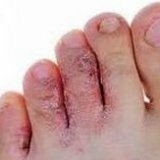Pemphigus in adults: types, symptoms, treatment
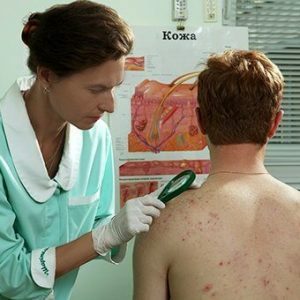 Pemphigus( pemphigus) - a dermatological disease, which is characterized by the appearance on the skin and mucous membranes of blisters( bullae).This is a rare and very serious disease.Often, adults face it at the age of thirty or sixty years, although the disease can occur at any age.
Pemphigus( pemphigus) - a dermatological disease, which is characterized by the appearance on the skin and mucous membranes of blisters( bullae).This is a rare and very serious disease.Often, adults face it at the age of thirty or sixty years, although the disease can occur at any age.
Causes of pemphigus
The cause of pemphigus are autoimmune disorders.With this disease, autoantibodies are formed to specific proteins - desmoglyines.This substance connects adjacent cells of the epidermis.When autoantibodies attack desmoglyins, the work of the latter is disrupted.Because of this, the epidermal cells are already loosely connected and separated from each other.The epidermis becomes porous, easily stratified, susceptible to the penetration of microorganisms.As a result, on the surface of the skin, vesicles with a serous fluid form, after the opening of which ulcers are exposed.The destruction of the connection between epidermal cells is called acantholysis, therefore pemphigus is called acantholytic.
Acantholytic pemphigus( pemphigus) and pemphigus of newborns are completely different diseases.While at the heart of pemphigus are autoimmune disorders, pemphigus of newborns is caused by staphylococcus.

Symptoms of pemphigus
Pemphigus in adults is a chronic disease with a wave-like current, that is, the alternation of periods of extinction of clinical manifestations and exacerbations of the disease.A characteristic sign of the disease is the appearance of bubbles( bullae).
Bubbles can be localized on the mucous membranes of the mouth, upper respiratory tract, external genitalia, skin. There are several forms of pemphigus:
- Ordinary( vulgar);
- Vegetating;
- Sheet;
- Erythematous( seboric);
- Brazilian.
Ordinary pemphigus
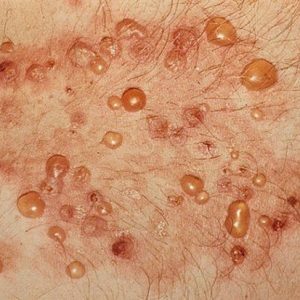
This is the most common form of pemphigus in adults.It starts usually unnoticed, for no apparent reason.The disease manifests itself with the appearance of blisters on the mucous membrane of the mouth, the red border of the lips, nose, and nasopharynx.The patient is concerned about pain when swallowing food and saliva, when talking.In addition, marked salivation and, characteristic of, an unpleasant odor from the mouth.Often patients treat such symptoms with a dentist or an otolaryngologist and are treated unsuccessfully for stomatitis, rhinitis, or laryngitis.
After several months( from three to twelve), the pathological process begins to actively spread to the skin.On the skin appear transparent flabby bubbles with serous fluid inside, which quickly open, literally in the first day.In their place, erosions are exposed with a bright pink and moist, and therefore a shiny surface.The serous fluid flowing out of the bull is scraped into crusts.Bubbles can occur on any site, without any favorite localization.A typical sign of acantholytic pancreatitis is a positive symptom of Nikolsky.With this symptom, rubbing the skin in a lesion site or on a healthy fragment leads to exfoliation of the epidermis.
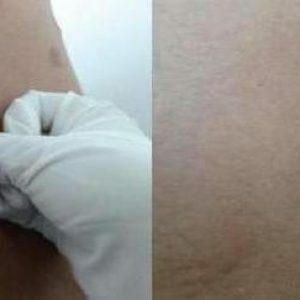 In a moderate process, the general condition of a person remains unchanged.However, pemphigus can acquire a generalized character when large blisters and ulcers form on the skin.In this case, the state of health deteriorates, weakness, loss of appetite, weight loss.Skin with pemphigus is extremely susceptible to microorganisms.There is a possibility of attaching pathogenic microflora with severe consequences.
In a moderate process, the general condition of a person remains unchanged.However, pemphigus can acquire a generalized character when large blisters and ulcers form on the skin.In this case, the state of health deteriorates, weakness, loss of appetite, weight loss.Skin with pemphigus is extremely susceptible to microorganisms.There is a possibility of attaching pathogenic microflora with severe consequences.
Erythematous( seborrheic) pemphigus
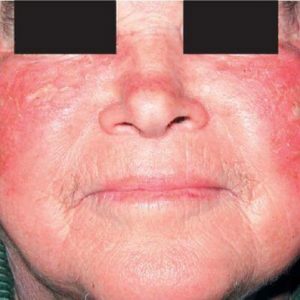
Erythematous pemphigus is rare.The peculiarity of this type of pemphigus is that the first rashes are localized on the skin, namely in areas with a large accumulation of sebaceous glands: the face, the scalp, the back, the chest.On the skin are formed erythematous( red) spots with clear boundaries.Externally, this clinical picture resembles seborrheic eczema.
Soon on these erythematous spots appear bubbles, on their surface you can see brown or yellowish crusts.When the crusts are rejected, erosion with a moist surface is exposed.The disease can occur in a limited form for several years, and can spread further along the skin.The mucous mouth is rarely affected.
Pasteid pustyrus
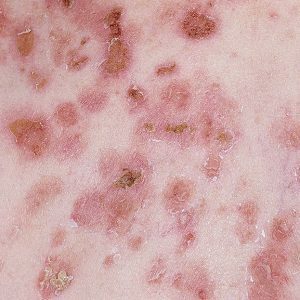
The leaf pemphigus is very similar to the ordinary pemphigus.This form is isolated separately because acantholysis occurs in the upper layers of the epidermis.
Bubbles can occur anywhere on the body, but are often localized in the face area, as well as the scalp.The lid of the blisters is very thin and tears at the slightest irritation.After they are opened, the serous fluid flows outward, and layered scaly crusts form covering the ulcer.
The defeat of the oral mucosa is rare in this form of pemphigus.In this case, the eye can be affected with the formation of purulent conjunctivitis.
Pessivorous pemphigus
This kind of pemphigus can be benign for a long time( the rashes occupy limited areas of the skin) and do not affect the overall well-being.Bubbles arise mainly on the mucosa of the mouth, around the nose, anus, genitals, and also in large folds of the skin( axillary, inguinal, in women under the breast).
For this type of pemphigus, it is characteristic that soft growths appear on the bottom of the erosion - vegetations covered with serous coating.Vegetations exude an unpleasant odor, and in sizes can reach a centimeter.
In general, the allocation of various forms of pemphigus is relatively arbitrary.After all, one variety of pemphigus can resemble another.In addition, it is possible to transform one form into another.
Brazilian pemphigus
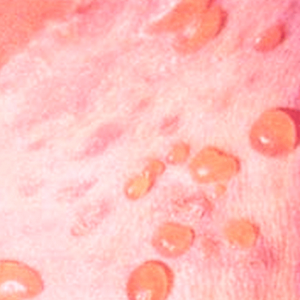
In its clinical manifestations it resembles leaf-like pemphigus.This ailment is found among the inhabitants of Brazil, Northern Argentina, Peru, Bolivia, mainly in the tropical regions.Improvement of housing conditions and deforestation led to a reduction in morbidity.Physicians suggest that the Brazilian pemphigus is probably of an infectious nature, but its activity is supported by environmental factors.An ailment often affects several family members, with more predisposed women.
On the skin appear flat bubbles, which then crack with formation of scaly crusts.The patient may complain of burning skin, which is why the Brazilian pemphigus is called "wild fire".
Diagnosis
If suspected of acantholytic pemphigus, a cytologic examination of the smear from the ulcer is performed.In the study, the laboratory assistant can detect the acantholytic epidermal cells of Tzanka, which indicate the presence of pemphigus in the patient.
Histological examination of the skin area can also be performed.With pemphigus, intercellular edema is found in the epidermis, acantholytic integrity disorders, and blisters.
With the help of an immunological study between the epidermal cells in the area of the bladder, it is possible to detect the deposits IgG, IgA.
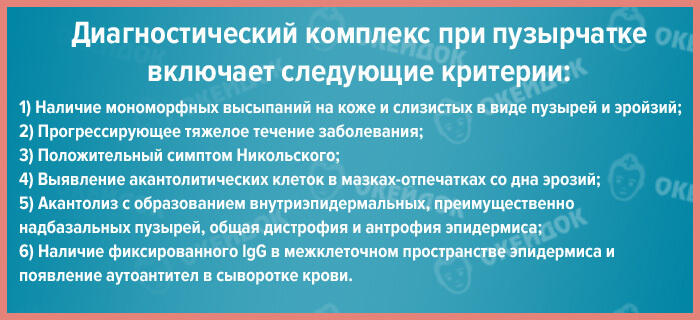
Treatment of pemphigus
The principle of treatment is to suppress the pathological activity of the immune system.For this purpose, glucocorticosteroids( Prednisolone, Methylprednisolone) are used.Often the doctor begins treatment of the patient immediately with large doses in order to affect the pathological process as soon as possible.This dose should be taken to the patient within four to six weeks, then the dose is gradually reduced.With a small dose of the drug there are relapses of the disease.
In addition, glucocorticoids can be used in combination with immunosuppressive drugs( Azathioprine, Methotrexate).The use of an immunosuppressive medication allows the use of a smaller dose of glucocorticoids, reducing their side effects.
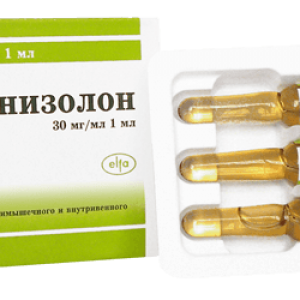 Glucocorticoids are heavy drugs that, if used for a long time, can cause serious complications.However, patients with acantholytic pemphigus can not choose, because their life is at stake.That is why it is necessary to comply with the prescription of the doctor and do not change the treatment plan independently.
Glucocorticoids are heavy drugs that, if used for a long time, can cause serious complications.However, patients with acantholytic pemphigus can not choose, because their life is at stake.That is why it is necessary to comply with the prescription of the doctor and do not change the treatment plan independently.
In the most severe form of the disease resort to pulse therapy.This is a short-term introduction of high doses of glucocorticoids and cyclophosphamide according to a certain scheme.As an additional method, plasmapheresis is performed, which allows a rapid reduction in the level of antibodies in the blood.In case of infection, the patient is prescribed antibiotics.
As an external treatment, blisters on the skin are treated with solutions of aniline dyes( fucorcin).To treat the oral cavity, rinsing with solutions with anti-inflammatory action is practiced.
The prognosis for acantholytic pemphigus is conditionally unfavorable.On the one hand, in the absence of effective treatment, there is a high probability of complications and death.On the other hand, patients with pemphigus are forced to take glucocorticosteroids for a long time, and sometimes for life, which is fraught with the development of side effects.But the hasty abandonment of drugs leads to an immediate relapse of the disease.Glucorticosteroids do not eliminate the cause of the disease, but they inhibit the pathological process and do not allow its progression.
Grigorova Valeria, medical reviewer

